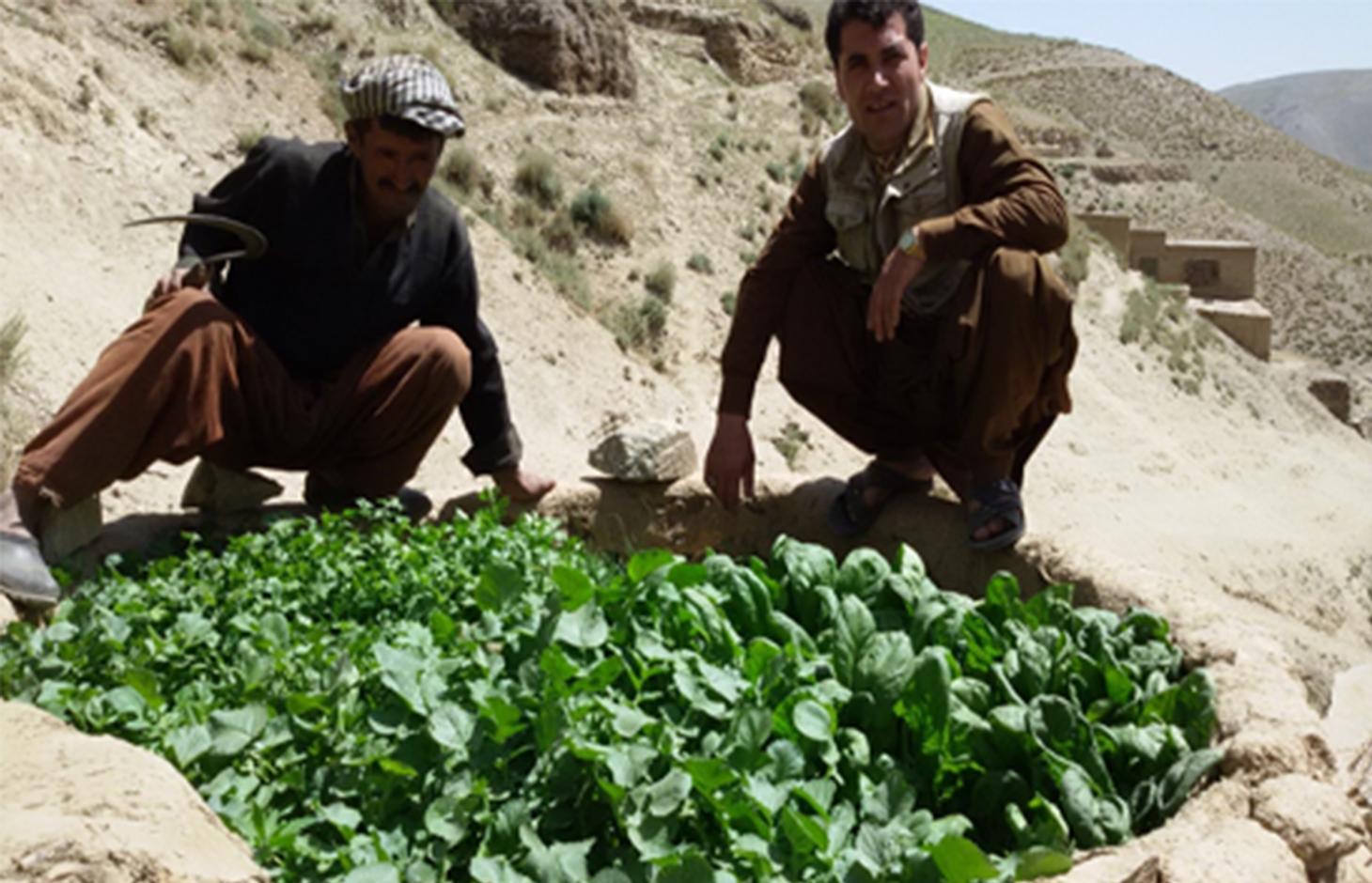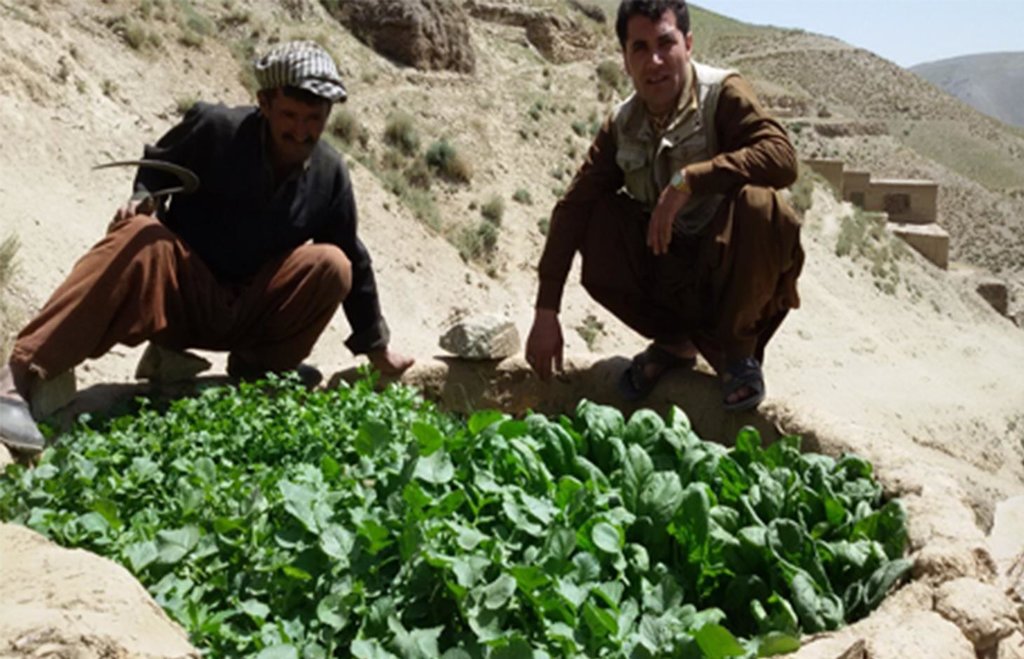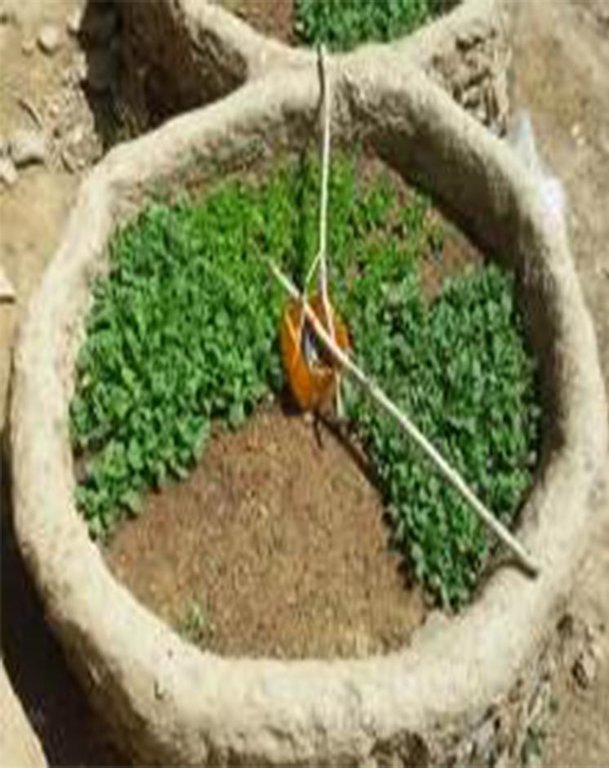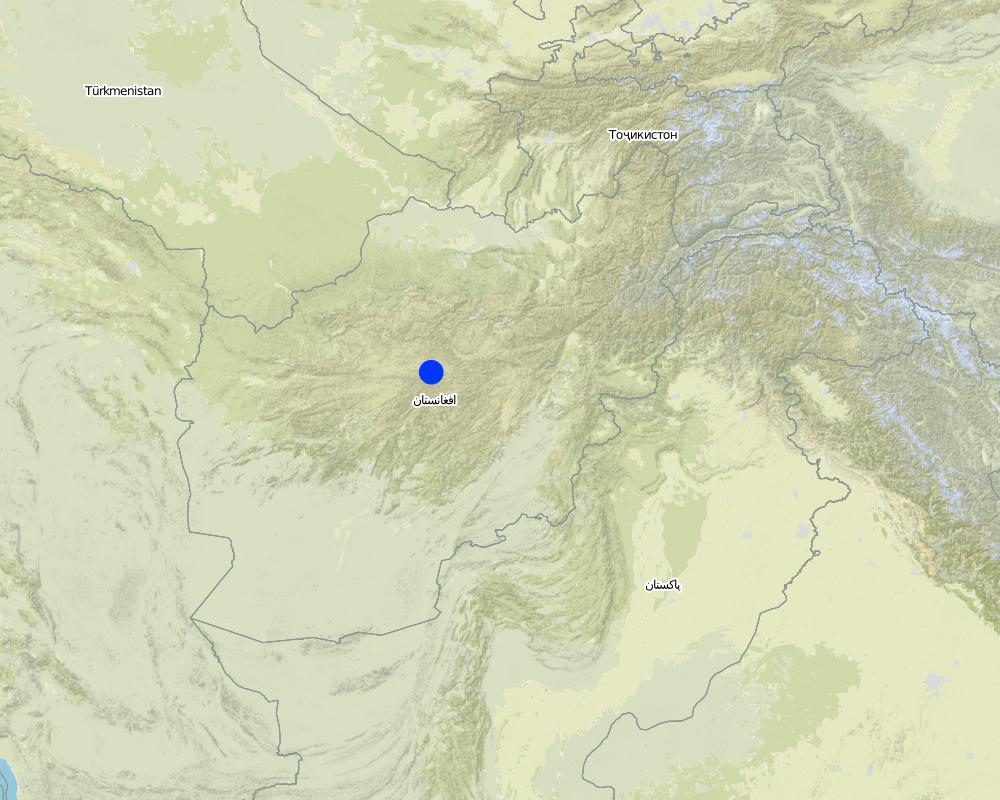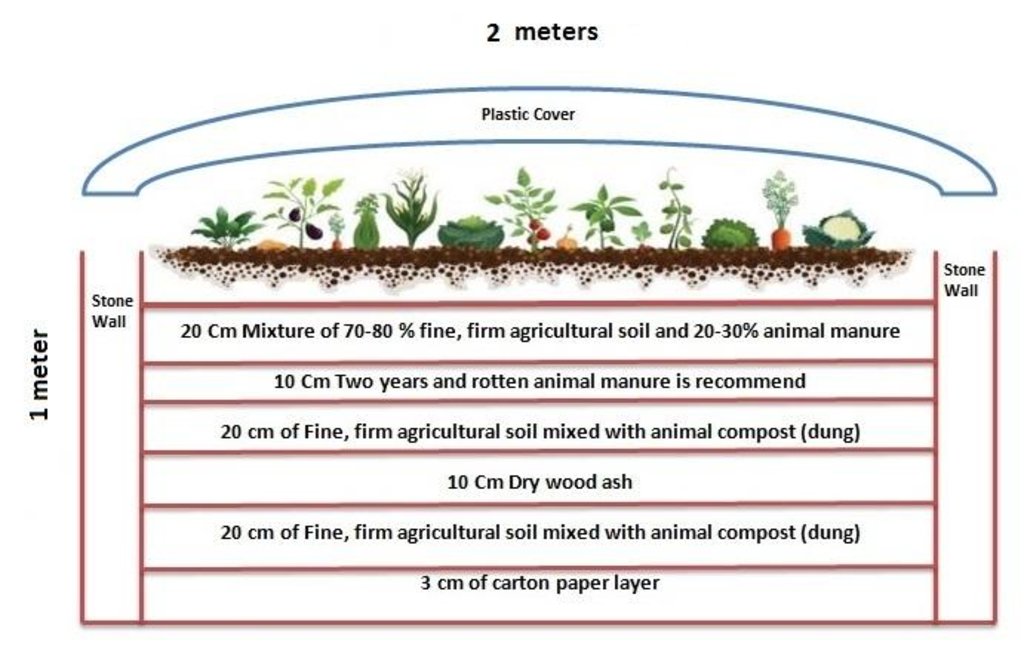Keyhole Garden [阿富汗]
- 创建:
- 更新:
- 编制者: Aqila Haidery
- 编辑者: –
- 审查者: David Streiff, Alexandra Gavilano
Baghche_e_Khanagi
technologies_1722 - 阿富汗
查看章节
全部展开 全部收起1. 一般信息
1.2 参与该技术评估和文件编制的资源人员和机构的联系方式
SLM专业人员:
SLM专业人员:
SLM专业人员:
Fuleki Blanka
HELVETAS Swiss Intercooperation
有助于对技术进行记录/评估的机构名称(如相关)
HELVETAS (Swiss Intercooperation)有助于对技术进行记录/评估的机构名称(如相关)
Action Contre La Faim (ACF) - 阿富汗1.3 关于使用通过WOCAT记录的数据的条件
编制者和关键资源人员接受有关使用通过WOCAT记录数据的条件。:
是
2. SLM技术的说明
2.1 技术简介
技术定义:
Keyhole garden farming offers farmers the opportunity to increase production while decreasing garden area.
2.2 技术的详细说明
说明:
The Keyhole garden technology is documented by Sustainable Land Management Project/HELVETAS Swiss Intercooperation with financial support of Swiss Agency for Development and Cooperation (SDC) and close support and cooperation of the Action Against Hunger International (ACF).
Keyhole gardens were introduced to the Laal_wa_Sarjangal community members to offer them the opportunity to produce vegetables in a small garden area. Keyhole gardens are raised beds that hold moisture and nutrients due to an active compost pile placed in the center of a round bed.
Purpose of the Technology: Keyhole gardens provide opportunities for poor, landless people to grow vegetables and improve their diets. Keyhole gardens are well-suited to places with limited arable land and to fine-textured, clayey soils which do not dry quickly. Keyhole gardens drain and warm up earlier in the spring, which allows planting of cool season vegetable on recommended planting dates. During heavy rain, water is absorbed without erosion. Thus, this technology helps the farmers access year round vegetable production.
Establishment / maintenance activities and inputs: Keyhole gardens are constructed in several steps by layering animal manure and soil, which contributes to soil fertility and drainage. A base layer, that prevents water loss, is made from plastic and carton in the bottom part of the keyhole garden. Then a central watering point is chosen that allows water to disburse into the keyhole garden layers. Leveling the surface of the keyhole garden ensures that all seeds/plants have access to the same amount of water, and helps ensure even germination.
The average size of the keyhole gardens is approximately two square meters. Construction is simple and cheap and can be easily implemented and replicated. The technology is very cost effective as local materials are used. Once they are built, keyhole gardens are easy to prepare for planting and to maintain throughout the growing season. Root crops grow longer and straighter in medium- to coarse-textured soils. Keyhole gardens are well suited to a wide range of intensive gardening techniques such as row covers, trickle irrigation, inter-cropping, successive plantings, compact varieties and mixtures of food and ornamental plantings. Keyhole gardens are usually close to home and are safe from animals, flood, avalanche and etc.
Natural / human environment: Laal_Wa_Sarjangal is one of the central districts of Ghor. It is mountainous and has a very cold dry climate (almost a five-month long winter). Livelihoods in the area are based on a mixture of rain-fed and irrigated agricultural production and animal husbandry. Market access is limited during the winter months when excessive snowfall blocks transportation routes.
2.3 技术照片
2.5 已应用该技术的、本评估所涵盖的国家/地区/地点
国家:
阿富汗
区域/州/省:
Ghor province
有关地点的进一步说明:
Lal Wa Sarjangal district
具体说明该技术的分布:
- 适用于特定场所/集中在较小区域
注释:
Boundary points of the Technology area: Lal Wa Sarjangal is one of the Ghor province district has bounderies with Chaghcharan, Kohestanat, Dawlatyar, Panjab, Yakawolang and Sang-e-Takht districts
Total area covered by the SLM Technology is 2.0E-6 km2.
Each keyhole garden structure is 2 square meters and constructed for one household to cultivate vegetables for home consumption. ACF has constructed 600 keyhole gardens in total.
Map
×2.6 实施日期
如果不知道确切的年份,请说明大概的日期:
- 不到10年前(最近)
2.7 技术介绍
详细说明该技术是如何引入的:
- 通过项目/外部干预
3. SLM技术的分类
3.1 该技术的主要目的
- 改良生产
3.2 应用该技术的当前土地利用类型

农田
- 一年一作

不毛之地
具体说明:
Wastelands, deserts, glaciers, swamps, recreation areas, etc
注释:
Major land use problems (compiler’s opinion): Lack of cultivable and fertile land, Scarcity of water, Sloppy and degraded land are the major land use problems.
Major land use problems (land users’ perception): Lack and scarcity of cultivable land.
Future (final) land use (after implementation of SLM Technology): Cropland: Ca: Annual cropping
Constraints of wastelands / deserts / glaciers / swamps: Lack of seedlings/seeds
Number of growing seasons per year: 1
Longest growing period from month to month: One season
3.3 由于技术的实施,土地使用是否发生了变化?

不毛之地
具体说明:
Wastelands, deserts, glaciers, swamps, recreation areas, etc
3.5 该技术所属的SLM组
- 家庭花园
3.6 包含该技术的可持续土地管理措施

植物措施
- V5:其它

结构措施
- S11:其它
注释:
Specification of other vegetative measures: Planatation of vegetables for household consumption
Specification of other structural measures: keyhole garden
3.7 该技术强调的主要土地退化类型

土壤水蚀
- Wt:表土流失/地表侵蚀
- Wm:块体运动/滑坡
注释:
Main causes of degradation: over-exploitation of vegetation for domestic use, population pressure
3.8 防止、减少或恢复土地退化
具体数量名该技术与土地退化有关的目标:
- 修复/恢复严重退化的土地
4. 技术规范、实施活动、投入和成本
4.1 该技术的技术图纸
技术规范(与技术图纸相关):
A detailed technical drawing of a keyhole garden (length: 2 m, height: 1 m) constructed by the technical support of Action Against Hunger International (ACF).
Technical knowledge required for field staff / advisors: low
Main technical functions: reduction of slope length, improvement of ground cover, water harvesting / increase water supply, increase vegetation
Secondary technical functions: improvement of topsoil structure (compaction), stabilisation of soil (eg by tree roots against land slides)
Vegetative measure: scattered / dispersed in Keyhole
Vegetative material: O : other
Vegetative measure: Vegetative material: O : other
Other species: Various vegetables
作者:
Ezatullah Noori, Action Against Hunger International
4.2 有关投入和成本计算的一般信息
具体说明成本和投入是如何计算的:
- 每个技术单元
指定单位:
Keyhole garden
指定单位面积(如相关):
length: 2 m, height: 1 m
具体说明成本计算所用货币:
- 美元
注明雇用劳工的每日平均工资成本:
6.00
4.3 技术建立活动
| 活动 | 时间(季度) | |
|---|---|---|
| 1. | Construction of the Keyhole garden with local available materials (plastic sheet, rope and water-cane) | |
| 2. | Plantation in the keyhole garden under ACF's supervision |
4.4 技术建立所需要的费用和投入
| 对投入进行具体说明 | 单位 | 数量 | 单位成本 | 每项投入的总成本 | 土地使用者承担的成本% | |
|---|---|---|---|---|---|---|
| 劳动力 | Construction of the Keyhole garden (seeds) | persons/day/unit | 1.0 | 6.0 | 6.0 | 30.0 |
| 劳动力 | Plantation in the keyhole garden | unit | 1.0 | 2.0 | 2.0 | 20.0 |
| 设备 | Water-cane | pieces | 1.0 | 2.0 | 2.0 | 30.0 |
| 施工材料 | Plastic sheet | meter | 2.0 | 1.25 | 2.5 | 30.0 |
| 施工材料 | Rope | meter | 2.0 | 0.75 | 1.5 | 30.0 |
| 技术建立所需总成本 | 14.0 | |||||
| 技术建立总成本,美元 | 14.0 | |||||
4.5 维护/经常性活动
| 活动 | 时间/频率 | |
|---|---|---|
| 1. | Plantation in the keyhole garden |
4.6 维护/经常性活动所需要的费用和投入(每年)
| 对投入进行具体说明 | 单位 | 数量 | 单位成本 | 每项投入的总成本 | 土地使用者承担的成本% | |
|---|---|---|---|---|---|---|
| 劳动力 | Plantation in the keyhole garden (seeds) | unit | 1.0 | 2.0 | 2.0 | 40.0 |
| 技术维护所需总成本 | 2.0 | |||||
| 技术维护总成本,美元 | 2.0 | |||||
4.7 影响成本的最重要因素
描述影响成本的最决定性因素:
The technology is low cost and can be accomplished by using local available materials
5. 自然和人文环境
5.1 气候
年降雨量
- < 250毫米
- 251-500毫米
- 501-750毫米
- 751-1,000毫米
- 1,001-1,500毫米
- 1,501-2,000毫米
- 2,001-3,000毫米
- 3,001-4,000毫米
- > 4,000毫米
农业气候带
- 半干旱
Thermal climate class: temperate
With long winter season
5.2 地形
平均坡度:
- 水平(0-2%)
- 缓降(3-5%)
- 平缓(6-10%)
- 滚坡(11-15%)
- 崎岖(16-30%)
- 陡峭(31-60%)
- 非常陡峭(>60%)
地形:
- 高原/平原
- 山脊
- 山坡
- 山地斜坡
- 麓坡
- 谷底
垂直分布带:
- 0-100 m a.s.l.
- 101-500 m a.s.l.
- 501-1,000 m a.s.l.
- 1,001-1,500 m a.s.l.
- 1,501-2,000 m a.s.l.
- 2,001-2,500 m a.s.l.
- 2,501-3,000 m a.s.l.
- 3,001-4,000 m a.s.l.
- > 4,000 m a.s.l.
5.3 土壤
平均土层深度:
- 非常浅(0-20厘米)
- 浅(21-50厘米)
- 中等深度(51-80厘米)
- 深(81-120厘米)
- 非常深(> 120厘米)
土壤质地(表土):
- 粗粒/轻(砂质)
表土有机质:
- 低(<1%)
如有可能,附上完整的土壤描述或具体说明可用的信息,例如土壤类型、土壤酸碱度、阳离子交换能力、氮、盐度等。:
Soil fertility is low
Soil drainage / infiltration is poor
Soil water storage capacity is medium
5.4 水资源可用性和质量
地下水位表:
5-50米
地表水的可用性:
中等
水质(未处理):
良好饮用水
5.5 生物多样性
物种多样性:
- 低
5.6 应用该技术的土地使用者的特征
非农收入:
- 收入的10-50%
相对财富水平:
- 贫瘠
个人或集体:
- 个人/家庭
性别:
- 女人
- 男人
说明土地使用者的其他有关特征:
Land users applying the Technology are mainly disadvantaged land users
Population density: 10-50 persons/km2
Annual population growth: 2% - 3%
5.7 应用该技术的土地使用者使用的平均土地面积
- < 0.5 公顷
- 0.5-1 公顷
- 1-2 公顷
- 2-5公顷
- 5-15公顷
- 15-50公顷
- 50-100公顷
- 100-500公顷
- 500-1,000公顷
- 1,000-10,000公顷
- > 10,000公顷
这被认为是小规模、中规模还是大规模的(参照当地实际情况)?:
- 小规模的
5.8 土地所有权、土地使用权和水使用权
- individual
土地使用权:
- 社区(有组织)
用水权:
- 社区(有组织)
注释:
means subject to community-agreed management rules.
5.9 进入服务和基础设施的通道
健康:
- 贫瘠
- 适度的
- 好
教育:
- 贫瘠
- 适度的
- 好
技术援助:
- 贫瘠
- 适度的
- 好
就业(例如非农):
- 贫瘠
- 适度的
- 好
市场:
- 贫瘠
- 适度的
- 好
能源:
- 贫瘠
- 适度的
- 好
道路和交通:
- 贫瘠
- 适度的
- 好
饮用水和卫生设施:
- 贫瘠
- 适度的
- 好
金融服务:
- 贫瘠
- 适度的
- 好
6. 影响和结论性说明
6.1 该技术的现场影响
社会经济效应
生产
生产区域
社会文化影响
食品安全/自给自足
livelihood and human well-being
注释/具体说明:
Vegetable cultivation in this area is newly introduced and has improved the health of the families. Even they can have access to vegetables in a colder season as well
dependence on external support
生态影响
水循环/径流
地表径流
土壤
土壤覆盖层
土壤流失
养分循环/补给
生物多样性:植被、动物
植被覆盖
6.2 该技术的场外影响已经显现
soil, vegetation and wastelands quality
buffering/filtering
6.3 技术对渐变气候以及与气候相关的极端情况/灾害的暴露和敏感性(土地使用者认为的极端情况/灾害)
渐变气候
渐变气候
| 季节 | 增加或减少 | 该技术是如何应对的? | |
|---|---|---|---|
| 年温度 | 增加 | 好 |
气候有关的极端情况(灾害)
气象灾害
| 该技术是如何应对的? | |
|---|---|
| 局地暴雨 | 不好 |
| 局地风暴 | 好 |
水文灾害
| 该技术是如何应对的? | |
|---|---|
| 比较和缓的(河道)洪水 | 不好 |
注释:
Construction of the technology in the protected and safe areas.
6.4 成本效益分析
技术收益与技术建立成本相比如何(从土地使用者的角度看)?
短期回报:
积极
长期回报:
非常积极
技术收益与技术维护成本/经常性成本相比如何(从土地使用者的角度看)?
短期回报:
积极
长期回报:
非常积极
6.5 技术采用
- 单例/实验
在所有采用这项技术的人当中,有多少人是自发的,即未获得任何物质奖励/付款?:
- 0-10%
注释:
1 land user families have adopted the Technology with external material support
Comments on spontaneous adoption: Many other land user families have implemented the technology with out any external material support, unfortunately information regarding the exact number of the families is not available.
There is a strong trend towards spontaneous adoption of the Technology
Comments on adoption trend: The technology, provided vegetables to the community all year round and even in an extremely cold weather.
6.7 该技术的优点/长处/机会
| 土地使用者眼中的长处/优势/机会 |
|---|
| Productive, can get high yields from a relatively small surface area, can extend the cultivation time if protected from frost and covered by plastic. |
| 编制者或其他关键资源人员认为的长处/优势/机会 |
|---|
|
Low cost, easy to replicate, requires little labor at the stage of establishment and can be done by beneficiary and requires little maintenance. How can they be sustained / enhanced? People can use local available materials |
|
Locally adaptable, doesn’t require productive land, the soil for cultivation could be easily prepared and managed, doesn’t require chemical fertilizers. How can they be sustained / enhanced? Technical support and training can be provided for the community members to change the land in to a productive land with out using any chemical fertilizer. |
|
Can be managed by females in the household, less chance for vegetables contamination. How can they be sustained / enhanced? Women should be encouraged and given technical assistance. |
|
Requires little water for irrigation. How can they be sustained / enhanced? The keyhole garden could be irrigated by kitchen waste water. |
6.8 技术的弱点/缺点/风险及其克服方法
| 编制者或其他关键资源人员认为的弱点/缺点/风险 | 如何克服它们? |
|---|---|
| Unavailability of seed | Can be solved through resourcing good quality seed from seed preservation. Start farming under plastic early in the spring to have enough time for seeds preservation. |
7. 参考和链接
7.1 信息的方法/来源
链接和模块
全部展开 全部收起链接
无链接
模块
无模块


